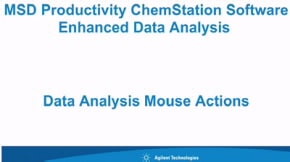Agilent Chemstation Software Tutorial


41 videos Play all OpenLab CDS Software Tutorial Series Agilent Technologies 19 Simple Psychological Tricks That Actually Work - Duration: 7:48. BRIGHT SIDE Recommended for you.
ChemStation - Level 1 - Training Sequencing concepts ChemStation - Level 1 - Training Building a Sequence for Automated Analysis 1. Go to the Method and Run Control view.
From the Sequence menu, select New Sequence. Edit the Sequence Parameters. Edit the Sequence Table. Select a Sequence Output. Save the Sequence 7. Run the Sequence form the RunControl menu or the Sequence Table. A sequence allows you to automate the analysis of many samples and update calibration tables automatically.
To define a sequence, go to the Method and Run Control view. From the Sequence menu, find the New Sequence menu item. Field genius keygen idm. This item will load a default sequence file, which is empty. Now, edit the Sequence Parameters.
The Sequence Parameters tell your ChemStation where to store the sequence generated data files. The Sequence Parameters will also tell the instrument to shutdown at the end of the sequence, if desired. The Sequence Table is accessed to input the vials, methods, and replicates; as well as, indicate which samples are calibration standards, samples, or controls. The Sequence Output will indicate where generated reports should go and if a sequence summary report is desired. Finally, before beginning the sequence, remember to save it.
April 04, 2002 Agilent Restricted Sequence Parameters Part of Methods to Run Run Time Checklist Runs each sample vial in the sequence from sample injection, through data acquisition, integration, calculations and reports according to the Run Time Checklist of the method. Acquisition Only Runs each sample vial in the sequence from sample injection, but only does data acquisition. Reprocessing Only Repeats integration, calculation and reports for the existing data files. No sample injections are made and no new data is acquired. Wait time: time needed for equilibration after loading another method nRdy Timeout The nRdy Timeout specifies the time in minutes the instruments wait for the software to be ready with processing (for example complex data analysis) before the instruments switch off. This is by default set to blank, no limit. Set this value if you want to make sure your instruments switch off automatically in case the PC controlling them is switched off or runs into a problem.
Hacking the bq8030 with SANYO firmware. The file is 2048 bytes and it has two sections. The first 1024 bytes contains the static data (the beginning of which you can see in the hex dump above). It contains all the data set by the manufacturer that never changes during the lifetime of the battery. Sanyo Tool Reset Bq8030 Datasheet. Battery capacity is stored as the remaining capacity reported through SBS divided by 2. Cycle count is stored as Cycle. Count- 1 (eg.: SBS value: 2. Eeprom byte: 2. 22)Remaining Capacity Alarm is stored as- is. A good place to start mapping. It's a good idea to reset the cycle counter. Sanyo tool reset bq8030 datasheet lm35 instructions.
April 04, 2002 Agilent Restricted Standard ALS Sequence Table Additional Columns in Sequence Tables: Sample Amount ISTD Amount Multiplier Dilution Data file Inj Volume See ChemStation Help File April 04, 2002 Agilent Restricted WPS Sequence table The set up sequence starts with well plate 1 at location A1 to B4 and ends on plate 2 where samples from B5 to G10 are analyzed. Sample table set up screen Th Text Previous Home Next April 04, 2002 Agilent Restricted Insert Vial Range Standard ALS There are two versions of the Insert Vial Range: Short and Full. Use the short version to insert a group of lines in the sequence table when Method Name, and Injection per Vial will be the same for each vial in the range.
Use the full version if these are calibration samples and Sample Name, Sample Amount, ISTD Amount, Multiplier, and Dilution will also be the same for every line in the group. April 04, 2002 Agilent Restricted Fill in Sequence Table Using Sequence Table Fill Down - Standard ALS The Sequence Table Fill Down dialog box allows the user to select available vial ranges and column headings for the fill down function. It function allows you to edit current sequence tables much more quickly. The Available vial ranges are determined automatically from the currently loaded sequence.
The user can select from any of the listed vial ranges. After selecting from the available vials, the range of values set in the ’From vial’ and ’To vial’ boxes can then be overridden by the user to fill a specific range of vials. The user may select any of the available sequence table columns and enter a value for the column.